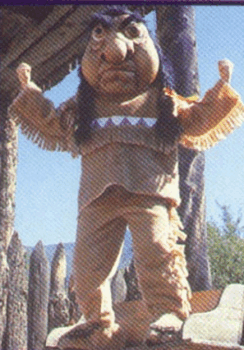Bobby (after Cindy steals his headdress): I'm gonna scalp her....I'm the real Little Owl.
Alice: Oh, I think she makes a heap pretty squaw.
The Brady Bunch
The historical image of the Indians is pretty well set, we are the bad guys who burned the wagon trains and images are the white man's game.
To be an Indian in modern American society is in a very real sense to be unreal and ahistorical.
Vine Deloria, Jr. (Standing Rock Sioux), Custer Died for Your Sins
The American public feels most comfortable with the mythical Indians of stereotype-land who were always THERE.
Vine Deloria Jr. (Standing Rock Sioux), quoted in Sorry for Not Being a Stereotype, Chicago Sun-Times, 4/24/04
Literature on Indians provides no clues to understanding the present or remembering the past. Much contemporary literature is a thinly disguised romanticism that looks at Indians as the last and best spiritual hope for a society disheartened and disorganized.
Vine Deloria Jr. (Standing Rock Sioux), American Indians, American Justice
The American educational system is successful only in teaching dominant society values, methods, and superiority. We read only of their successes and their heroes. Perhaps this is because non-Indians write the books.
Joe S. Sando (Pueblo), quoted in "Who Gets to Tell Their Stories?," New York Times Book Review, 5/3/92
There are 107 federally recognized tribes in the state [of California], more than in any other state. In San Diego County alone, there are 17 tribes, more than in any other county. But most of the focus in California schools is on the Great Plains Indians, said Al Schwartz, a professor of Native American history at Cal State San Marcos.
"Native American Indians in California have more cultures and more languages than anywhere I know in North America," Schwartz said. "But the images that we have are of people in horses, building tepees and shooting buffalo."
Which was not what life was like for California Indians, Schwartz said.
Edward Sifuentes, Proposed Bill Could Change American Indian History Lessons, North County Times, 3/6/01

As a counselor I am frequently asked to lecture on diversity at various universities. One little self-test I offer to the students to see if one harbors stereotypes is, I ask the students to close their eyes and envision an Englishman using a computer. Then I ask them to envision an Italian using a computer...then finally I asked them to envision an Indian using a computer. They always are surprised at themselves as they realize they envision the English and Italians as regular people and they invariably envision the Indians in buckskin, feathers, etc., and give no consideration to the Indian as a person.
Matt Sherman
"It's too obvious to say that current representations are damaging," says Todd, whose films have been screened worldwide, including at the Sundance Film Festival, New York University and the Museum of Modern Art.
"There is a legacy of misrepresentation — and of native people playing certain roles in the western imagination."
Todd, who has written and lectured extensively on Aboriginal media, believes that current public imagery of aboriginals sees them being stuck in the past, rather than as part of the present. It also tends to portray Aboriginal peoples as one-dimensional — acting either as positive or negative role models.
"The usual task of these representations is to cast us as part of a distant past, rather than a dynamic present," Todd says. "Or, if we are in the present, then it is only if we are good or bad role models — rather than human beings."
Burying the Stereotypes by Madeleine de Trenqualye, on independent filmmaker Loretta Todd, 12/21/05
The issue is here; do we allow our own children, our Indian children to have the respect that every other racial group in this country has? My own child as a first grader just a few years ago went to school. They brought a ‘mountain man' into discuss Indian relics. In the middle of the presentation he said, ‘I hold this big old knife over my head and when those Indians come at me I stab them with this little knife.'
That is the kind of things that are propagated by using Indians as a mascot or as a symbol. A mascot by definition begets not only prejudice, but begets patronage and paternalism. For us as Indian folks we don't want to be second class citizens.
Chad Smith, principal chief of the Cherokee Nation, Cherokee Chief, Equal Opportunity Advocate Square Off, Indian Country Today, 9/2/01


